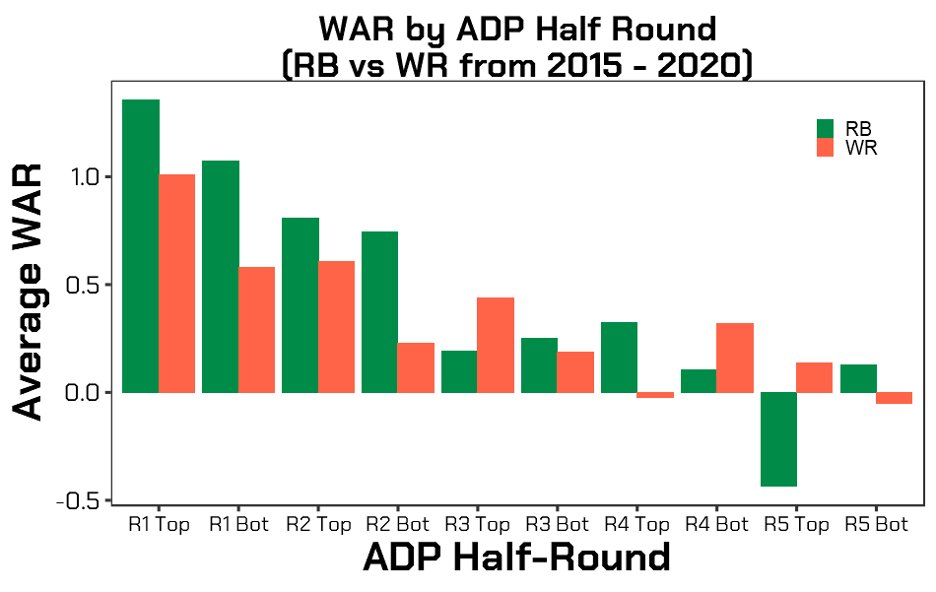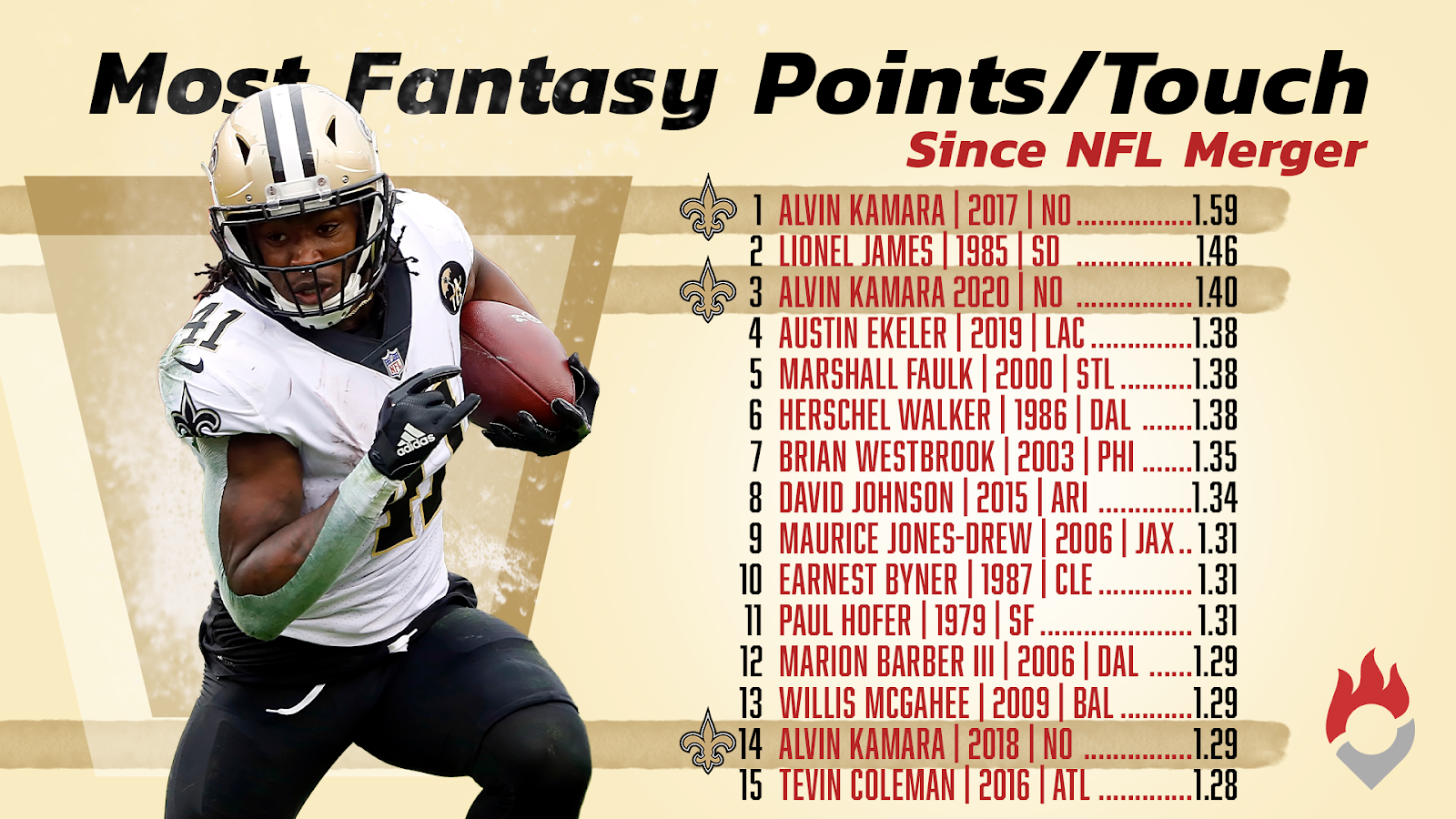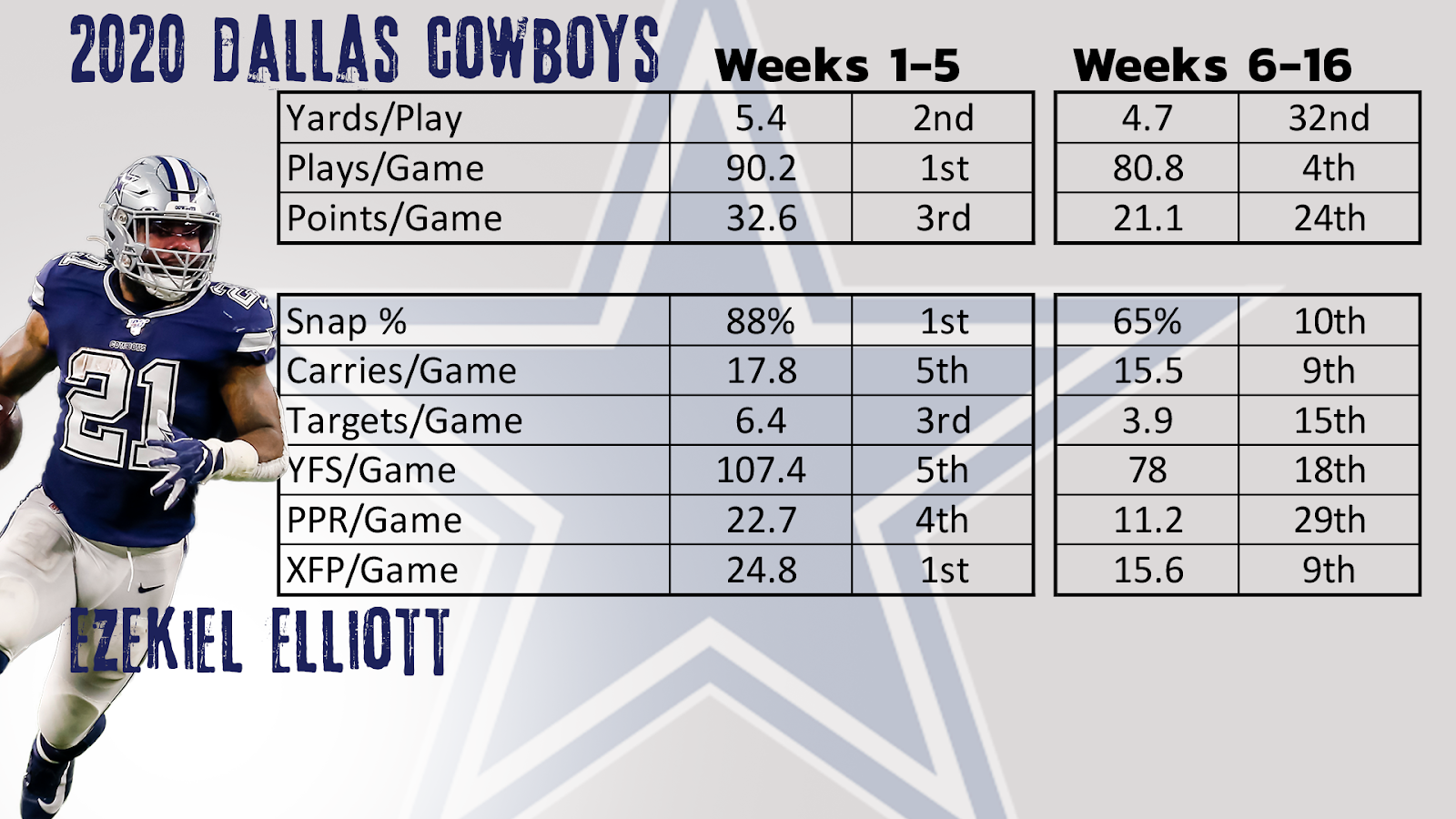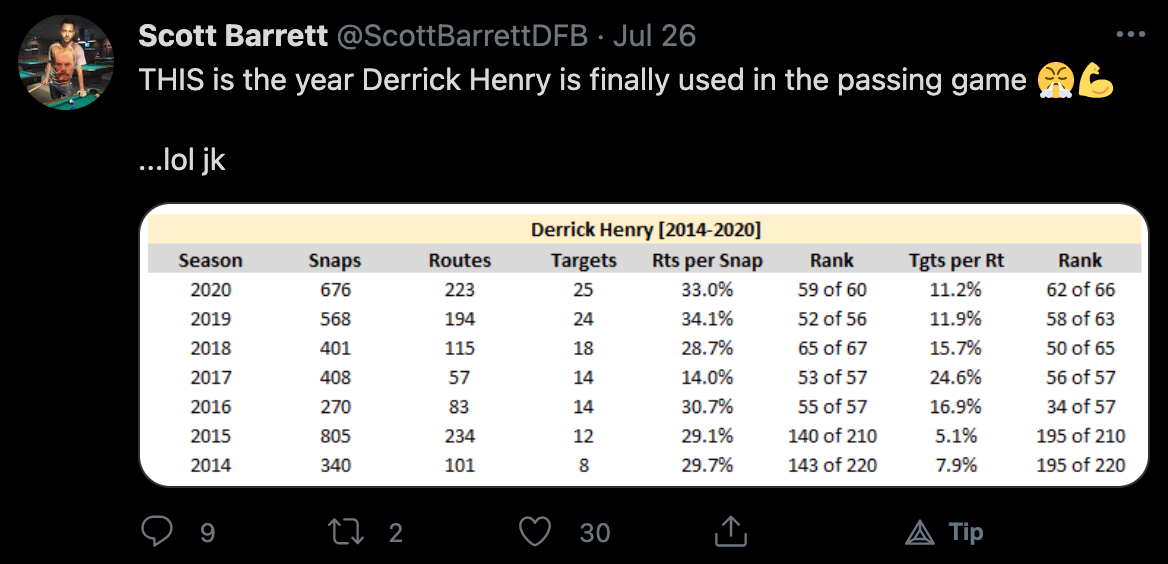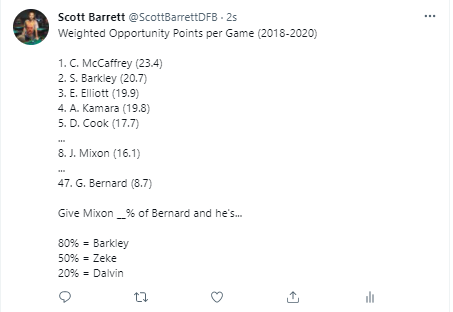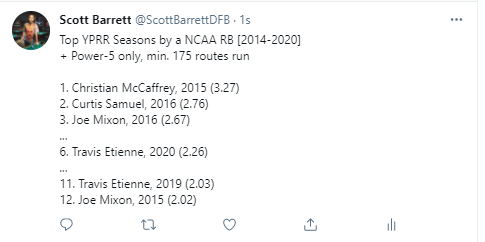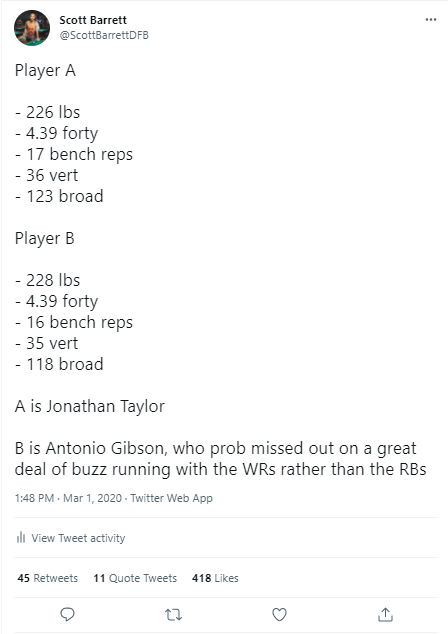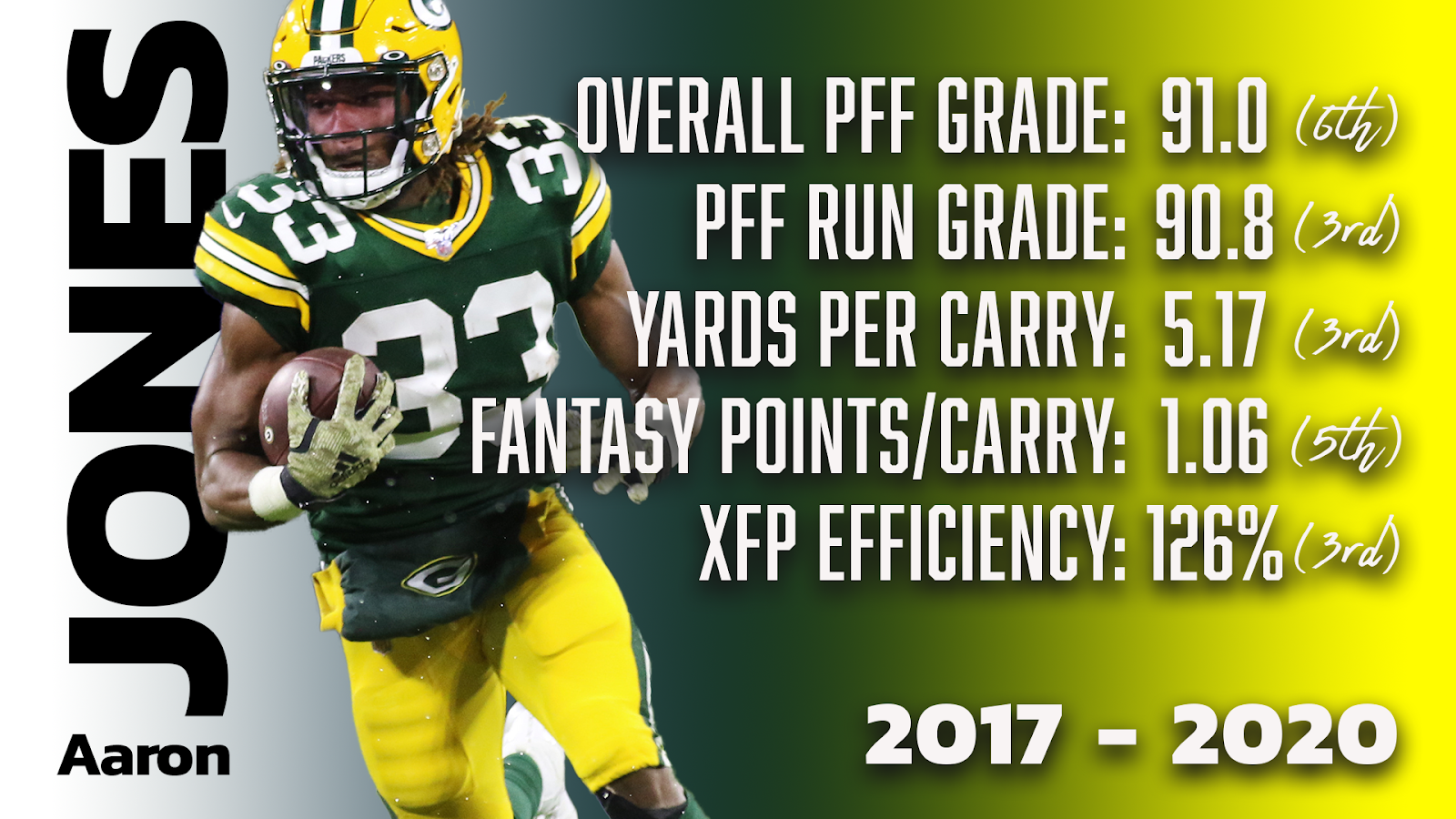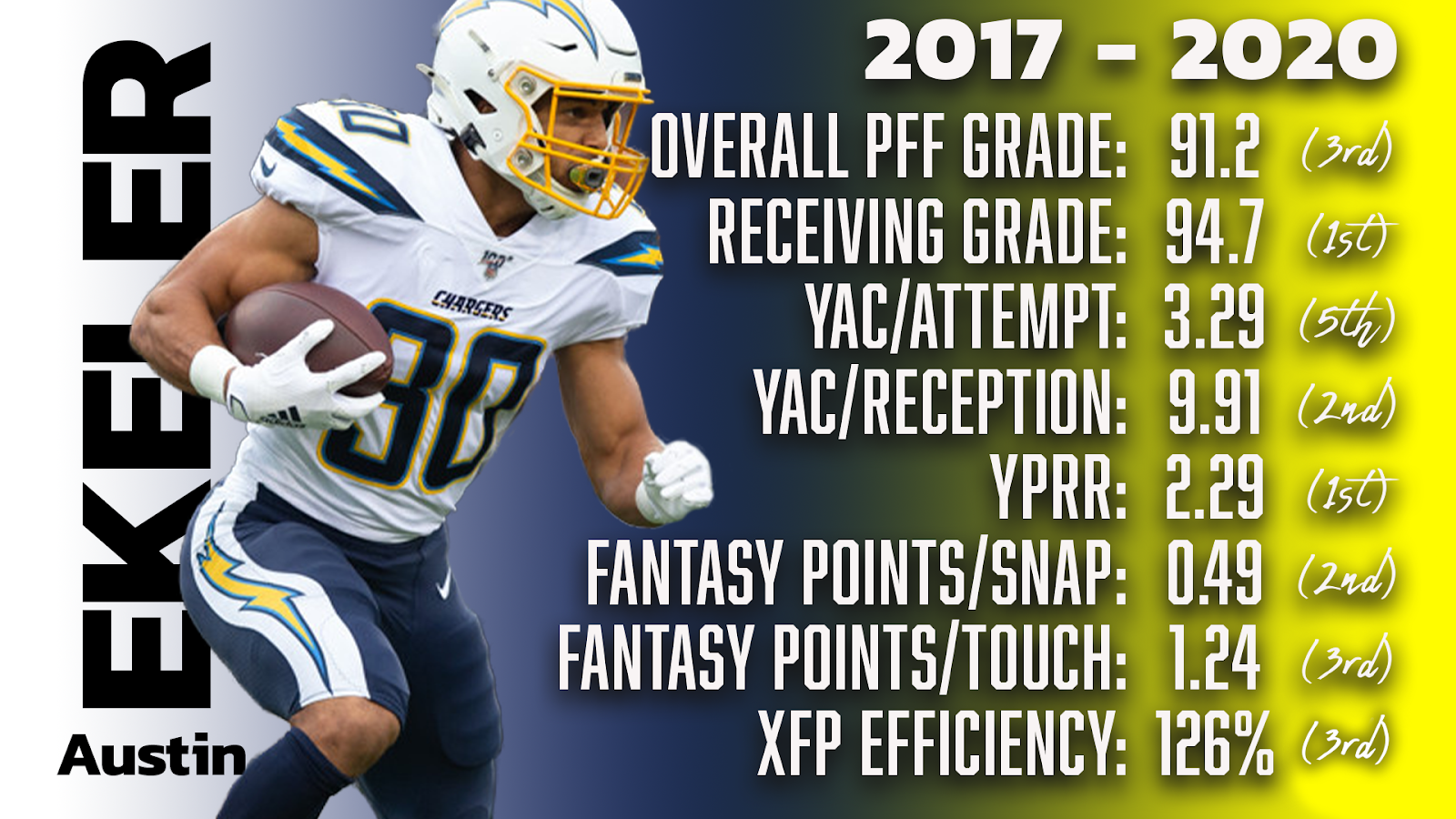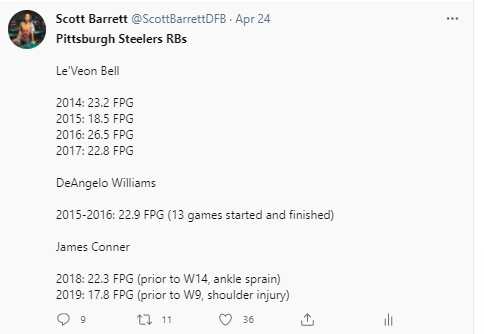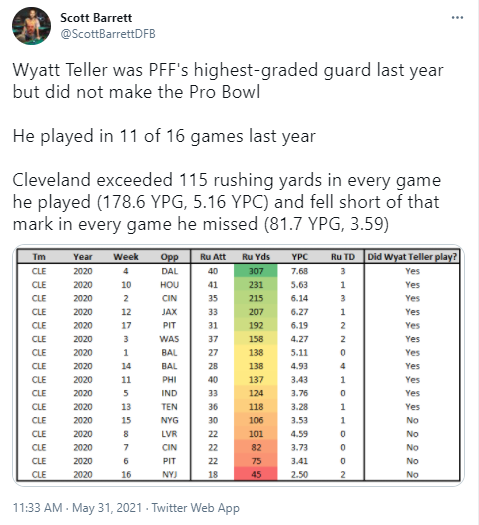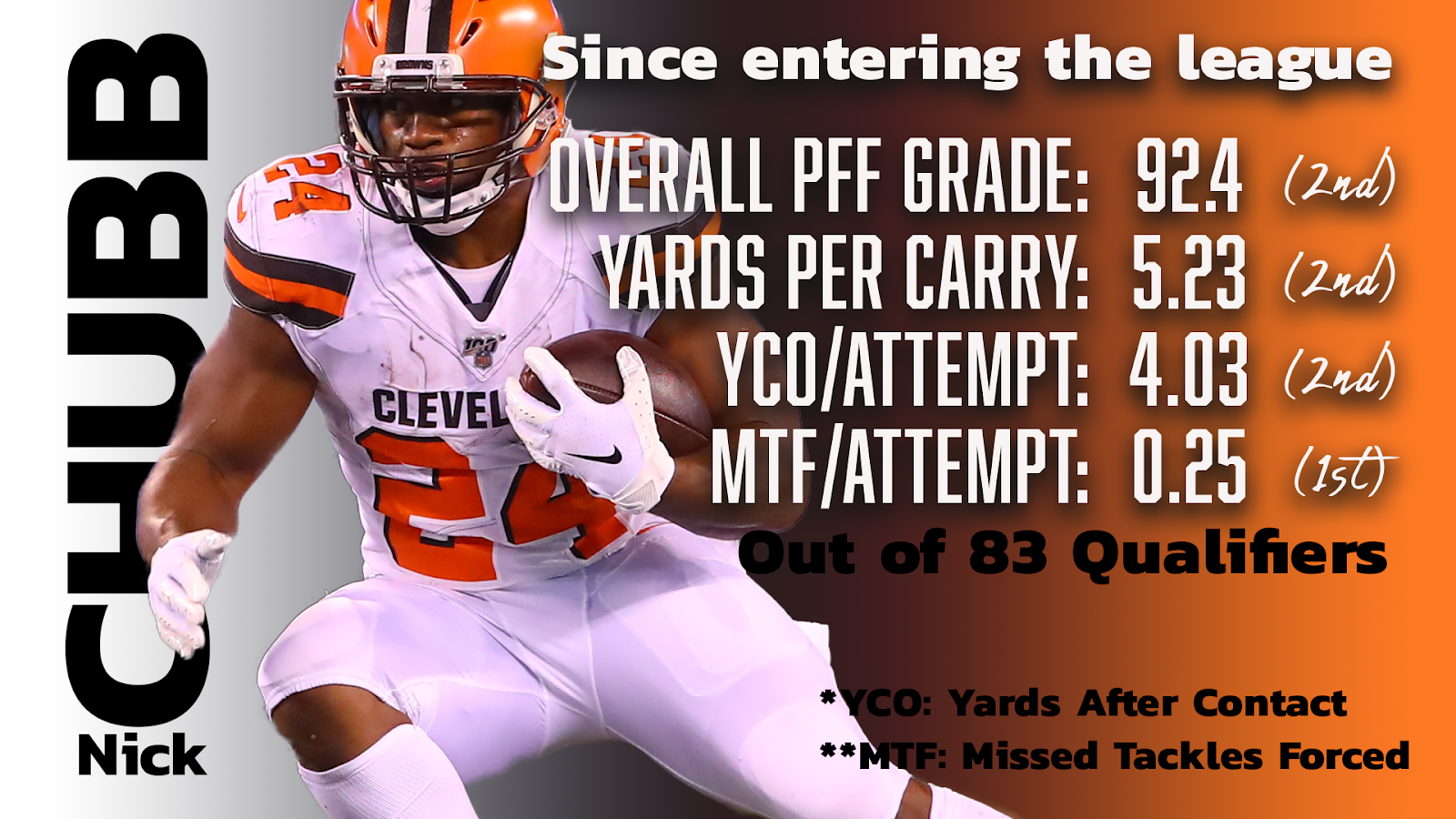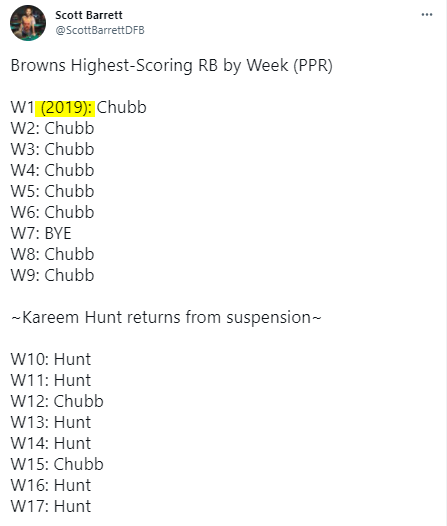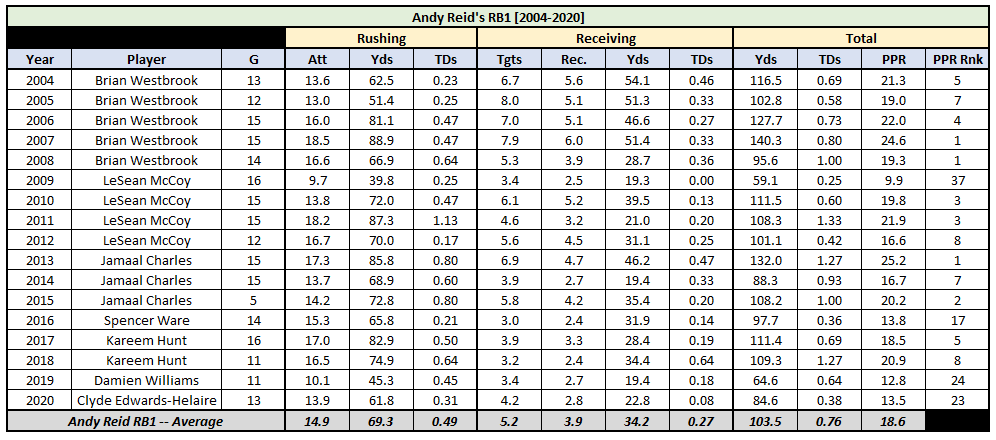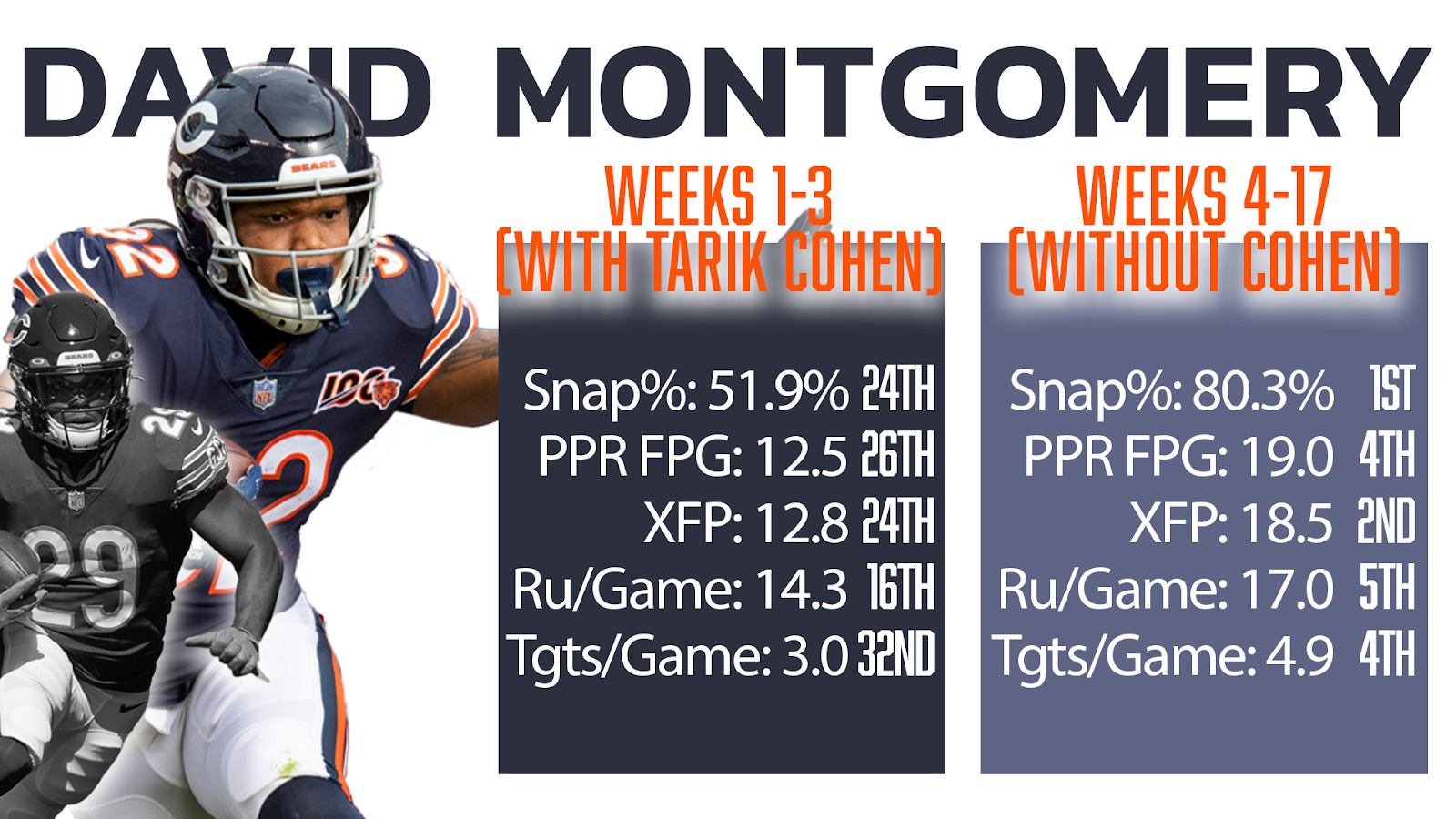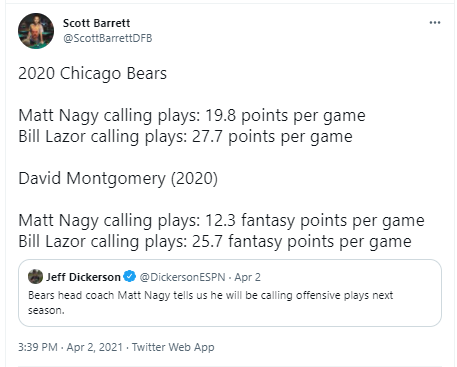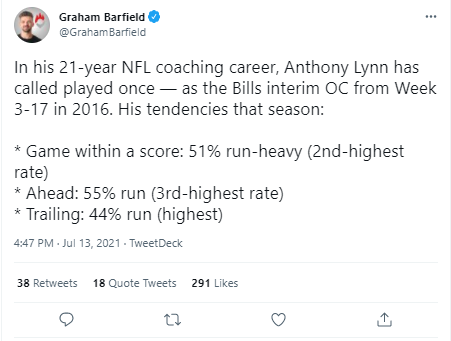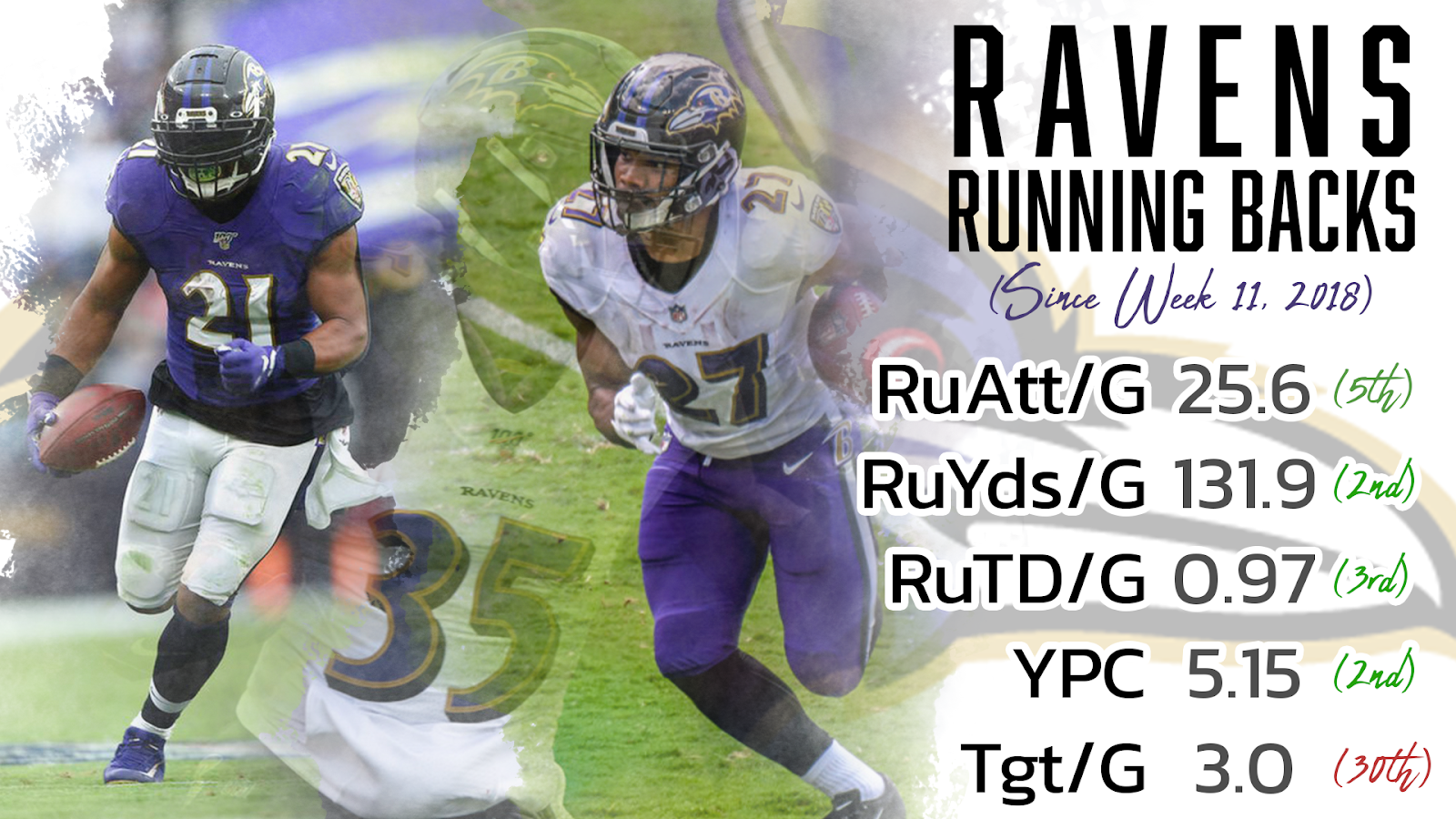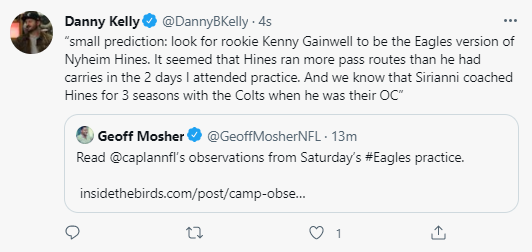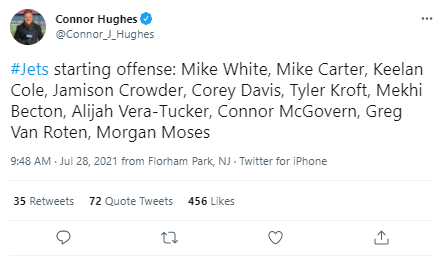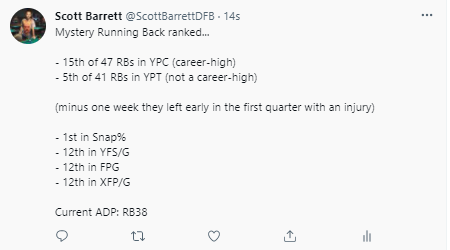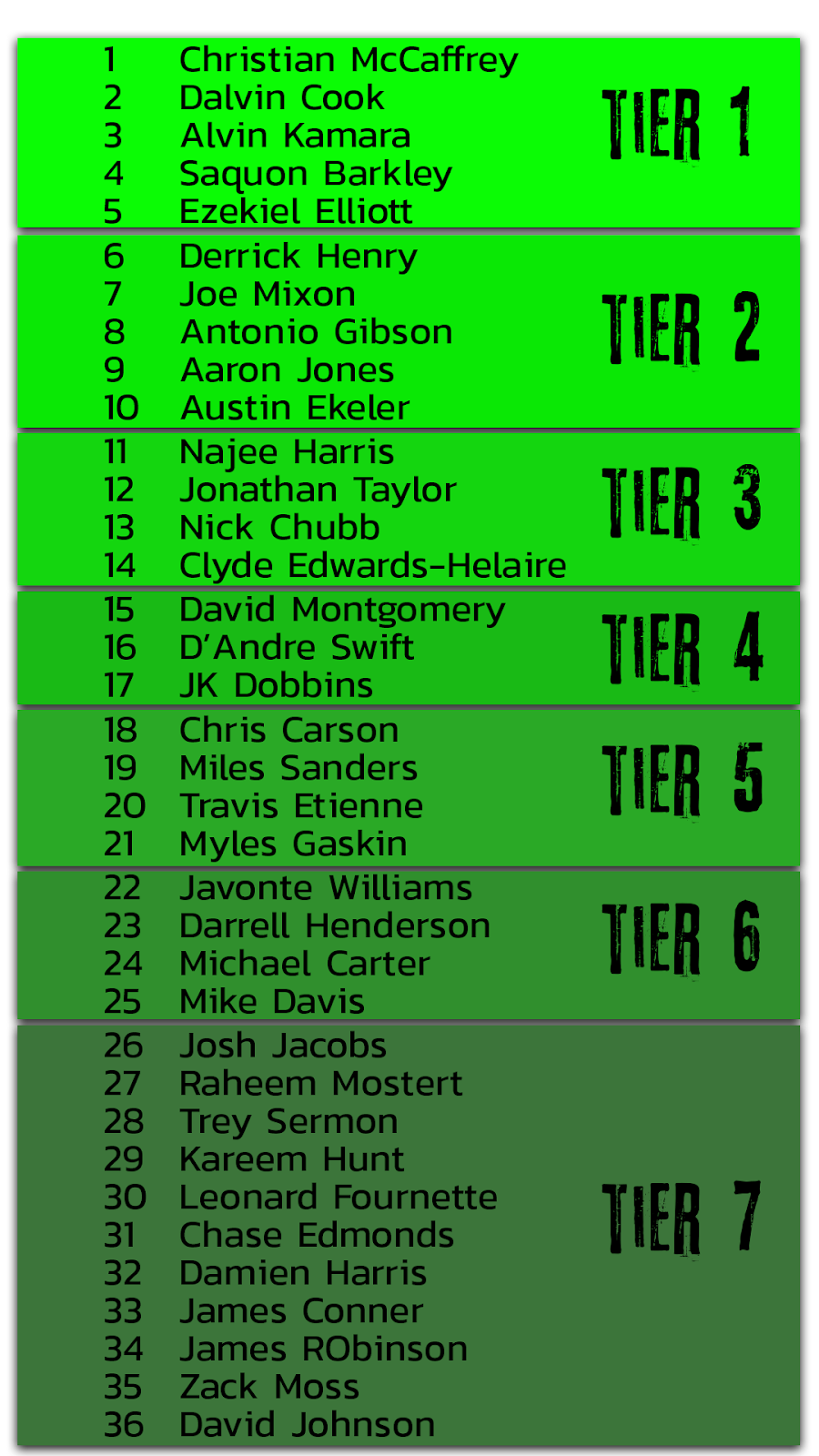If you’ve already read last year’s article – “Bell Cow or Bust” – then an introduction for today’s article isn’t necessary.
If you haven’t read that article then please do so now.
No, seriously…
All done? Okay, good.
So, who will be a bell-cow running back in 2021? Who are the running backs I’m drafting in 2021 and in what order? I’m glad you asked. But first I have some more mandatory reading for you (sorry!).
Last year was a terrible, horrible, no good, very bad year for the Bell Cow or Bust draft strategy. It was, easily, the worst bell cow season in at least a decade. In other words, it was an outlier year. What went wrong? How am I measuring this? I explained this all in detail, here.
Bell Cow or Bust is the right approach in a vacuum, optimal over a long enough timeline, but it won’t work perfectly every year. That’s true for every strategy. There’s going to be some outlier years. (Maybe even for late-round kicker.) But, yes, I do think this was just an outlier year. Yes, I do expect to see a major bell cow resurgence this year. Yes, I am predicting a major regression to the mean. Though, as you’ll see in a minute, I am no longer so rigid in my Bell Cow or Bust-approach.
Anyway, in today’s article I’ll be giving my detailed thoughts on all of the top-20 or so running backs by ADP, as well as a few other undervalued and underrated long-shot bets. In each section I’ll discuss a player’s upside, downside, and bell cow-potential. And for those of you who hate reading, I’ll be concluding this article with my current set of rankings.
Just note that all of this is specific to PPR start/sit leagues. Running back is the most important and most valuable position in fantasy. And bell-cow running backs are typically going to be the top league winners in any given season. That’s true, but the bell-cow distinction is significantly less important in standard (as opposed to full-PPR) leagues. And, in best ball leagues, it’s wholly irrelevant after Round 1. In fact, that’s a great format to go Zero-RB or, especially, modified Zero-RB.
Bell cows are typically going to be the top league winners in any given season, but bell cows are typically only found in the earliest rounds of your draft. So, while I will spend a great deal of time on some of the underrated “Dead Zone RBs” in this article (Tier 4 / Round 3 and beyond), I won’t end up drafting very many of them.
Ideally, I’m going RB-RB to start. Maybe even RB-RB-RB depending on who is there in Round 3. RB-RB means you probably need to draft one or two “Dead Zone RBs,” but that might not be necessary with a RB-RB-RB start. And in either case, you can always draft a few handcuff-type running backs in the last rounds of the draft, but I’m also rarely ever drafting those types of running backs outside of the last rounds, nor am I ever expecting to rely on them for meaningful production.
For reference, here are all running backs last season, by a weighted average that incorporates Snap%, Rushing Attempt%, and Team Target% in games active:
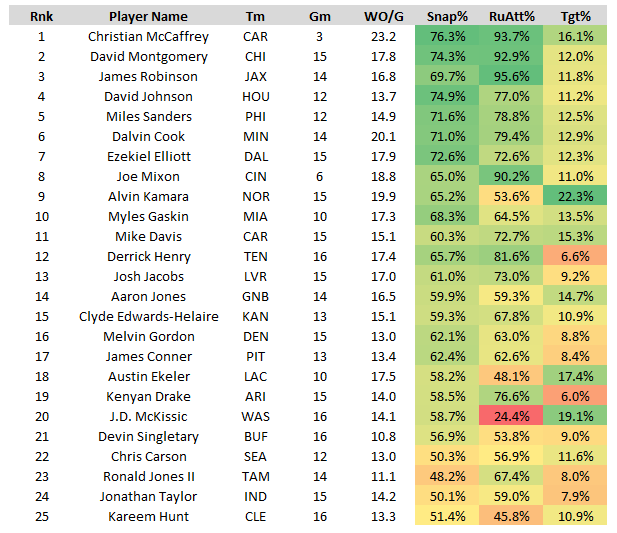
Tier 1
Christian McCaffrey, RB, Carolina Panthers
ADP: RB1
Rank: RB1
Bell Cow: Yes; the archetype
In 2019, McCaffrey became the first running back in at least a decade (maybe ever) to play on over 1,000 snaps. In total, he commanded 287 of 309 carries (92.8%) and 142 of 153 targets out of the backfield (92.8%). His 25.3 weighted opportunity points per game ranks 3rd-most all time, and his 29.5 fantasy points per game ranks 5th-most all-time. And that’s what that was, an all-time season – McCaffrey’s 2019 season rivals only the best years of Marshall Faulk and LaDainian Tomlinson as the archetypal bell-cow season.
In 2020, McCaffrey played only three games, but, when healthy, was the exact same player he was in 2019, averaging 19.7 carries, 6.3 targets, 23.2 weighted opportunity points, and 30.1 FPG. (For perspective, 30.1 FPG would have ranked 3rd-most by any player all time.)
The only on-paper concern with McCaffrey is that, following this injury, Carolina is at least a little more conservative with how they use McCaffrey in 2021, careful to keep him healthy and preserve him for a potential playoff run. That’s a concern, though, not a very serious one, as McCaffrey still has a long way to fall in terms of usage and still remain the unanimous 1.01.
In reality, McCaffrey is probably the closest thing to peak Tomlinson ever. Meaning, McCaffrey is in a tier all unto himself and the 1.01 is an incredible advantage this year – more so than in any year since maybe 2007. If you’re lucky enough to land the first overall pick in your draft, congratulations, it’s all about praying McCaffrey stays healthy and trying not to screw things up from there. If you weren’t that lucky, I don’t know, maybe your best strategy is just lobbying your commissioner to move over to an auction-style draft.
Dalvin Cook, RB, Minnesota Vikings
ADP: RB2
Rank: RB2
Bell Cow: Yes
Cook finished 2nd in FPG in 2019 (behind McCaffrey) and 3rd in 2020 (behind Alvin Kamara and McCaffrey), and ranks behind only McCaffrey (29.6) in FPG over this span (22.5).
With McCaffrey and Saquon Barkley hurt, Cook was the de facto top bell cow in 2020. He was the only running back to play in at least four games and handle at least 72.5% of his team’s running backs snaps in games active (76.9%) … though typically there are about 5.6 per season (obviously a reason to expect regression to the mean). Last year, excluding McCaffrey due to small sample size (which we will for the remainder of this article), Cook led all players in XFP per game (20.8), XFP market share (29.1%), and XFP positional market share (80.7%).
In other words, Alexander Mattison is no threat to Cook, who is in a tier all by himself as the unanimous 1.02 in fantasy drafts. He’s a high-end talent — ranking 3rd-best by PFF grade since 2017 — and is seeing highest-end volume. The offensive line is bad, but, after adding LT Christian Darrisaw in Round 1 and OG Wyatt Davis in Round 3, it shouldn't be any worse than it was last year. The team has a new offensive coordinator, but it’s the old offensive coordinator’s son, so the scheme shouldn’t be too different. (Cook ranked 2nd in rush attempts per game last year, despite the team’s 7-9 record.) And it’s a great scheme for a running back to be in — a Gary Kubiak-led offense has ranked top-seven in rushing yards in 15 of 24 (63%) career seasons. This, I think, should matter more than the uncertain status (possible demotion) of OL coach and run-game coordinator Rick Dennison. The only concern with Cook is injuries, and, granted, after missing at least two games in all four seasons, it’s a legitimate one.
Alvin Kamara, RB, New Orleans Saints
ADP: RB3
Rank: RB3
Bell Cow: Yes; McCaffrey minus about 6.0 carries per game
Bonus Stat: Michael Thomas is expected to miss at least the first five games of the season, and there's no guarantee he'll be anywhere close to 100% upon his return. Last season Kamara averaged 30.8 FPG in games Thomas missed (seven), as opposed to 18.7 FPG in games he played (six).
Kamara has finished 4th (20.0), 4th (23.6), 8th (17.8), and, last year, 1st (25.2) in FPG, with 2019 being something of an injury-outlier year. Over this span he’s ranked 13th (13.5), 5th (19.0), 5th (17.0), and, last year, 2nd (19.2) in XFP per game. By raw volume, Kamara is certainly a bell cow. By usage (in contrast to the other running backs on the team), he’s only a low-end bell cow, playing on at least, but barely above, 65% of the team’s snaps in 2018, 2019 (Weeks 1-5, when healthy), and 2020.
But his real role is sort of tricky to define. He’s sort of a scatback on steroids — maybe 60% a workhorse and 140% a scatback. (Remember, in PPR leagues, a target is worth 2.64 times as much as a carry for running backs.) Or, maybe even part-wide receiver, part-running back (at least in fantasy terms). Last season Kamara ranked 3rd among running backs in rushing fantasy points (189.2) and would have ranked 31st among wide receivers in receiving fantasy points (188.6).
Things get trickier with Kamara, specifically, because he’s also inarguably the most efficient running back of all-time. We just about always see a regression to the mean following a hyper-efficient fantasy season (the differential between XFP and actual fantasy points scored). Volume is just so much stickier and more predictive than efficiency. That’s true, but Kamara is one of maybe only a handful of players who has proven his “mean” (that we’re regressing to) is substantially higher and stickier than that of any other player. In other words, 10 carries and five targets means a lot more to Kamara than it does to just about any other running back in the league.
Over the past three seasons (and of 70-plus qualifiers in each season), Kamara has finished 1st, 1st, 19th (2019), and 1st in fantasy points per snap. Among all 100-carry running backs since the NFL merger (1970), Kamara has seasons ranking (of 2,312 qualifiers) 1st (2017), 3rd (2020), and 14th-best (2018) by fantasy points per touch. For perspective, he's the only running back to crack the top-20 more than once, let alone three times.
Anyway, Kamara is awesome. His role is awesome. Or at least, has been awesome. The only concern is QB-play, and, specifically, volume rather than efficiency. Over the past decade, no quarterback has targeted running backs more often than the statue-like Drew Brees (26%). Jameis Winston’s rookie season was the only time he was above 18%, targeting Charles Sims and Doug Martin on 21% of his throws. Hyper-mobile quarterbacks rarely target running backs, and we saw that last year when Taysom Hill was under center. Kamara averaged just 4.0 targets per game with Hill under center (14% target share), though he averaged 8.3 (25%) in all other games.
That’s a concern, but I think not one big enough to push him any farther down than 1.03-overall. Kamara is still, easily, the 2nd-best receiver on the team when Thomas is healthy and the No. 1 when Thomas is out. This is still Sean Payton’s RB-centric scheme and team, and he’ll find a way to get the ball in the hands of his best players.
Saquon Barkley, RB, New York Giants
ADP: RB8
Rank: RB4
Bell Cow: Yes; the closest thing to McCaffrey when healthy
As a rookie in 2018, Barkley led the position in total fantasy points, averaging 24.1 FPG. He totaled the most fantasy points by any rookie all-time, and the 15th-most fantasy points by any running back in any season ever.
2019 didn’t go as smoothly. He suffered a high ankle sprain in Week 3, and it was clear he was rushed back just a bit too soon. From Weeks 3-14 Barkley averaged just 3.06 YPC and 13.6 FPG. Across Barkley’s other five games he averaged a whopping 27.1 FPG along with a ridiculous 6.74 YPC.
2020 was even more disappointing. He saw a whopping 15 carries and 9 targets in Week 1, and then suffered a season-ending ACL injury on the first play of the second quarter in Week 2.
Now, in 2021, don’t expect the Giants to make the same mistake they did in 2019. All indications point to them taking things intentionally slow with Barkley’s recovery. I wouldn’t be surprised if he missed the first few games of the season, and if he saw a diminished workload for at least several weeks upon his return. Further, I remember discussing Dalvin Cook with Dr. David Chao in 2019. He told me he was worried about Cook in his first year back following ACL surgery, both in terms of re-injury (specifically compensatory injuries) and in terms of diminished efficiency. (Cook averaged 14.2 FPG and missed five games in the middle-bulk of the season.) But 2019 was the year to target him, as that’s typically when a skill-position player will be back to full health following an ACL surgery. (He averaged 21.2 FPG and only sat out the last two games of the season, after the Vikings locked up a playoff spot.)
This is all legitimately concerning, but I will say, for fantasy, the first month of the season doesn’t matter anywhere near as much as the final month of the season. And backup RB Devontae Booker can be cheaply acquired in drafts (RB62) as a fill-in for those early games Barkley might sit out.
Otherwise, Barkley has everything you’re looking for. When healthy, he’s the closest thing in the game to Christian McCaffrey. He’s a full-on gamescript-proof bell cow, averaging 16.0 carries and 6.5 targets per game throughout his career. And, more impressively, playing on at least 77% of the team’s snaps in 27 of 31 career games. Barkley will also be playing behind the best offensive line and in the best offense of his career. Add this all up, and his sky-high upside is still well worth the very legitimate risk he carries as a top-five pick.
Ezekiel Elliott, RB, Dallas Cowboys
ADP: RB5
Rank: RB5
Bell Cow: Yes
Since entering the league, Ezekiel Elliott has finished 3rd (21.7), 3rd (20.3), 6th (21.9), 5th (19.5), and last year 15th (14.9) in FPG. What went wrong?
Well, a lot.
Tony Pollard ate a bit more into Elliott’s workload, as his snap share dropped from 84% in 2019 to 72% in 2020. He was also significantly less efficient, hitting career lows in PFF grade (65.3), yards per carry (4.0), yards after contact per attempt (2.8), missed tackles forced per touch (0.18), and yards per route run (0.87). There’s a legitimate risk that this is “just who he is now” and Tony Pollard will continue to steal work, but I don’t think that’s very realistic. More so, this is just an obvious and understandable outlier year for a $90 million running back who battled multiple injuries (hamstring, calf) on a league-worst offense.
Losing Dak Prescott to a season-ending ankle injury was devastating to both Elliott and the Dallas offense. Their season was basically dead at that point (which might have played a role in Elliott’s diminished workload from that point on), and efficiency was hard to come by with opposing defenses stacking the box against Andy Dalton (5.34 ANY/A), Garrett Gilbert (4.88), and Ben DiNucci (2.92). Dallas ranked 2nd-best in yards per play through the first five weeks of the season (5.4), but dead-last following Prescott’s injury (4.7). Elliott led the league in XFP per game (24.8) through those first five weeks (and, might I add, despite overwhelmingly negative and pass-heavy gamescripts in those games), but saw that number drop to 15.6 for the remainder of the season.
Luckily, Dak Prescott is back to full health and Dallas’ offense should also be fully back and roaring with him healthy. And with that should come an improvement in gamescript. Dallas is projected to win 9.5 games this year, after winning only six games in 2020. And that’s significant. Although Elliott is a high-end bell cow, averaging 18.5 carries and 5.2 targets per game over the last three seasons, he’s still (surprisingly) very gamescript-sensitive. Over this span, he averages +7.5 more FPG in wins than losses. Using these splits, and based on Vegas’ projection, we can expect Elliott’s FPG average to jump from 15.4 to 19.4. For perspective, that would have been the difference between finishing 15th and 5th at the position last year.
Elliott also had the league's 5th-toughest schedule last season (-1.45). But, lucky for him, his schedule ranks 5th most-improved, and worth a boost of about +0.69 to his FPG average. And Dallas’ offensive line ranked 27th-best by PFF last year, but ranks (projected) sixth-best this year with everyone healthy.
In addition to a positive regression in terms of strength of schedule, team efficiency, offensive line efficiency, and gamescript, we should also expect a positive efficiency regression from Elliott himself. Due to some brutal touchdown luck, Elliott finished 5.4 touchdowns shy of his volume-based expectation in 2020, which ranked worst among all players. This alone was worth a boost of +2.2 FPG to his 2020 average, or the difference between him finishing 15th and 6th at the position.
Add all this up and it’s clear Elliott — who, by the way, is apparently “way quicker, way more elusive” than he was last year — deserves to retain his top-5 ranking in 2021.
Tier 2
Derrick Henry, RB, Tennessee Titans
ADP: RB4
Rank: RB6
Bell Cow: Arguably; highest ideal of a workhorse running back
Whereas Kamara can be called a “scatback on steroids,” Henry is the highest ideal of a workhorse running back. On paper, you can make the case for Henry as a bell cow. Last season he played on 66% of the team’s snaps, and handled 82% of the carries and 58% of the team’s targets out of the backfield. That’s just about bell cow usage by positional market share, but not on volume. Because, while he did rank 3rd among all running backs in total expected fantasy points, averaging 17.6 per game, and that’s great (though nowhere near as good as his actual production), he saw only 25 targets all year. And so, he wasn’t a bell cow; he was just a two-down running back — just 5% of his total touches came on third-down — and was a total non-factor in the passing game.
So, he wasn’t a bell cow, but, again, he was the highest ideal of a workhorse running back. He was the heart, soul, and focalpoint of the offense. He ranked behind only McCaffrey, Cook, and Kamara in team XFP% (25%). Again, that’s great, but because he wasn’t involved in the passing game, he was far more gamescript-dependent than a bell cow running back. He averaged just 13.5 XFP per game in losses (19% XFP%) and 19.4 XFP per game in wins (27%). Over the past three seasons, he averages +11.6 more FPG in wins than losses; and, so, he’s basically been unstartable in games Tennessee lost (10.5 FPG).
That’s a big concern. Tennessee dramatically overachieved last season, winning 11 games, or 2.5 more than their Vegas implied win-total. Vegas is predicting only 9.0 wins for the Titans this year, and if that’s correct, (using these splits) we should expect Henry’s average to drop from 20.9 to 16.6 FPG. And if they fall two wins short of that mark, we can expect him to average just 15.3 FPG. That’s a major concern. You have to hope Ryan Tannehill stays healthy, continues to play at a Mahomesian level, and that Arthur Smith wasn’t the real catalyst behind Tennessee’s recent success.
That’s my chief concern, one far bigger than worries over Henry losing the tread on his tires following back-to-back 320-plus touch seasons. But even so, and in spite of my bell cow-bias, it’s hard to rank Henry much lower than this. He’s one of the greatest pure runners in the game — probably of all-time — and, like Kamara, a true outlier in terms of efficiency. He’s out-scored his volume-based expectation by +5.0 FPG over the past two seasons, which leads all running backs.
Joe Mixon, RB, Cincinnati Bengals
ADP: RB14
Rank: RB7
Bell Cow: Yes
Joe Mixon has never been a bell cow. He’s always been a heavily game-script-dependent workhorse. And, on a Bengals team that’s won fewer than 30% of their games since he entered the league, that’s been a problem. Over the past three seasons, Mixon averaged 11.9 more FPG in victories (25.2 FPG) than losses (13.3). The good news is, Vegas is expecting Cincinnati to improve, bringing their win-total up from four to 6.5. The better news is, with Giovani Bernard now in Tampa Bay, I think Mixon is finally going to be a bell cow.
OC Brian Callahan told reporters in May, “I don’t want Joe to leave the field, personally, and I think he’s up to that challenge … Joe shouldn’t come off the field, he should be on the field every down. He’s aware of that.” Per ESPN beat writer Ben Baby, Mixon has been lining up “at different WR spots” during training camp. Per The Athletic’s Paul Dehner, “Assuming health, this will be the largest workload of Joe Mixon’s career. Tag an extra 15-20 receptions to his previous totals… I think you’ll see him in the rarified air of the 80 percent snap rate and that should mean monster numbers…”
I don’t know why it’s taken so long, but it looks like Mixon will finally be a bell cow. And with Samaje Perine and Round 6 RB Chris Evans as his only competition, I’d say the sky’s the limit for Mixon in 2021. At the very least, he’s a smash-value at current ADP (RB14). Remember, Mixon was an elite receiver in college (see below), and was compared favorably to Matt Forte coming out (by PFF.)
And last year, although Mixon wasn’t yet a bell cow, his workload was better than ever. Despite Bernard stealing passing-down work and the Bengals winning just one game with him healthy, Mixon averaged 19.8 carries, 4.3 targets, 16.9 fantasy points, and 19.2 XFP per game. Those numbers ranked 3rd-, 13th-, 8th-, and 2nd-best over the full season. Again, the sky’s the limit for Mixon should he stay healthy. But, given his track record, and following a Lisfranc sprain (without surgery), injury risk is a very legitimate concern. But, I think, that’s the only concern.
Antonio Gibson, RB, Washington TBDs
ADP: RB12
Rank: RB8
Bell Cow: Arguably; anywhere from workhorse-plus to 2016 David Johnson
Bonus Stat: Last season Gibson ranked just 38th in snap share when active (43%), but still finished 18th in FPG (14.7). He ranked 2nd-best in fantasy points per snap (0.51), sandwiched in between Alvin Kamara (0.57) and Nick Chubb (0.51).
In his final year at Memphis, Gibson totaled a whopping 1,104 YFS on just 71 touches, averaging an absurd 11.2 YPC and 19.3 YPR. He effectively played slot WR for the Tigers, as only 33% of his yards came on the ground and just 12% of his snaps came out of the backfield.
After a dominant showing at the Combine, Gibson was drafted in Round 3 (as a running back), and, following the pick, both HC Ron Rivera and OC Scott Turner compared him favorably to Christian McCaffrey. Washington was then so impressed with Gibson’s progress in camp that they anointed him the Week 1 starter, after parting ways with Adrian Peterson and Derrius Guice.
I expected way more passing work from Gibson as a rookie, but, to my surprise, Washington used him as a workhorse rather than a bell cow. Instead, J.D. McKissic played the scatback role and led all running backs in targets with 110. It was Gibson’s first season playing the position — he had just 33 career carries at Memphis. But he was awesome in that workhorse role, averaging 10.4 rushing FPG (9th-most) along with a 4.68 YPC average.
This, of course, is highly encouraging. He was raw, and still excellent, perhaps pointing to an even greater ceiling. In particular, though his immense pass-catching upside (as a former wide receiver) went largely untapped as a rookie, still hints at McCaffrey-esque bell cow-potential.
And that’s an important (although, obviously, lofty) comparison. Washington OC Scott Turner coached both running backs. Both Scott and his father (Norv Turner) have always talked about the importance of a versatile every-down bell cow to their scheme. And how it has an outsized importance specific to their scheme — how they like to move guys around, make note of, diagnose, and then later expose defensive tendencies and to take advantage of mismatches in the passing game. Whereas having a strict workhorse/scatback committee can tip off opposing defenses as to whether you’ll be calling a pass or run play. And you probably don’t need me to remind you what McCaffrey did in 2019 under Scott Turner.
So, where do we stand in 2021? If Gibson is who he was in 2020, he’s overvalued. If he is who I think he is, he’s an underpriced potential league-winner. It makes very little sense to continue to pigeonhole a former WR into a strict-workhorse role. McKissic saw a lot of volume last season, but, simply, Gibson was better. He ranked 6th of 47-qualifying running backs in missed tackles forced per touch (0.18), and was twice as efficient as McKissic at forcing missed tackles as a receiver. The only area where Gibson underwhelmed in comparison (but this is important) was as a pass-blocker.
Last year running backs coach Randy Jordan warned of a steep learning curve and the immense odds stacked against Gibson, “[N]ot having any preseason games. It hurts him as a player because he has not played… Gibson’s versatility is an asset, but it also creates some issues in that he didn’t participate in many running back meetings in college to learn the details of the position, such as blocking or protection schemes… He's clay.” Gibson saw near-zero work as a pass-blocker in college and, last year, ranked 3rd-worst among 78 qualifying running backs in PFF pass block grade (22.9), while McKissic ranked around average (61.7).
The plan last year was to see Gibson’s role grow as the season progressed. We saw that start to play out in Week 12, when he saw season-highs in snap share (65%), carries (20), targets (7), and fantasy points scored (36.6). He could have been a bell cow and a true league-winner down the stretch, but, unfortunately, that never materialized as he suffered a toe injury early in the team’s next game and spent the remainder of the season inactive or listed as questionable on the injury report.
And everything out of Washington this summer has backed up the notion that Gibson is likely to make a massive leap in his sophomore season. Rivera was asked about his expectations for Gibson in Year 2 and answered, "I expect he can make a big jump." How does he look in camp? Jordan, the running backs coach, told us, "It's like night and day." He continued, "The biggest thing for him is continuing to progress, not only as a runner but as a pass-catcher. That's something we haven't really tapped in[to] a lot." ESPN beat writer John Keim earlier reported the team wants to “to expand his game to have him run more routes."
Basically, Gibson is one of a few players with McCaffrey-esque upside. That’s baked quite a bit into his RB12 ADP, but his floor also probably isn’t too far off of that mark.
Assume at a minimum Gibson gets the 15.0 carries per game and 3.4 targets per game he averaged across the five games prior to his Week 13 injury. He scored 21.8 FPG over this span, but in terms of volume, that’s just 14.6 weighted opportunity points per game, which would have ranked only 16th-best if over the full season. But if Gibson gets 80% of McKissic’s 6.9 targets per game, he’s basically Christian McCaffrey, averaging 23.5 weighted opportunity points. With just 50% of McKissic's targets, he's still top-3 in either of the past two seasons (20.1). And with 30%, he's still top-7 (17.9).
Of course, we haven’t yet seen it from Gibson. This is still very much a projection. But that’s also what you have to do at the running back position. And running backs do tend to make a sizable leap in their sophomore seasons, and that should especially be the case for Gibson due to his inexperience playing the position. He just needs to stay healthy. But, unfortunately, the lingering toe injury further complicates matters and adds to the risk. Still, at cost, I think all of the risks are well worth the cost of acquisition.
Aaron Jones, RB, Green Bay Packers
ADP: RB11
Rank: RB9
Bell Cow: Arguably; low-end bell cow at worst
Last season Jones finished 5th in total fantasy points and 4th in FPG (18.5). In 2019, he finished 2nd in total fantasy points and 4th in FPG (19.9). And now he ranks just 11th among running backs in ADP. And that’s in spite of the fact that Jamaal Williams, who averaged 8.1 carries and 2.9 targets per game over this span, is no longer with the team.
Williams totaled 70 receptions over the last two seasons, but Dillon averaged just 3.8 catches per season (1.7% of his total touches) dating back to 2017. So, while Dillon may steal an even greater share of the rushing work than what Williams saw in Green Bay, it’s hard to imagine Jones’ volume (in terms of XFP) doesn’t improve overall. Right?
Well, Jones is tricky to define in bell cow terms. Last season, he played on just 60% of the team’s snaps (or 65% adjusting for blowouts) and handled only 63% of the team’s backfield XFP (15th-most) in games active. But he handled 23% of the team’s total XFP, which ranked 4th-most. He ranked just 10th in XFP per game last year (16.3) and 7th in 2019 (15.8). But he’s also massively out-produced his volume-based expectation over this span (120%). And he’s shown enough over the course of his career that we should, I think, continue to see him out-score his expectation at one of the highest rates in the league.
Jones isn’t quite a bell cow, though he has seen good enough volume. But if he’s not a bell cow, what is he? He’s not a strict workhorse like Nick Chubb. And he’s not a scatback-on-steroids like Kamara or Ekeler. He’s used in both the passing and running game to near-equal degrees, but he’s seemingly forever and inexplicably been capped at something like 65% of the backfield’s total volume.
So where do we stand with Jones now that Williams is gone? It’s hard to say. Last season Williams handled 36% of the carries and 38% of the team’s targets out of the backfield in games active. That’s really not a ton of work in weighted opportunity terms, and thus, seemingly, not a major boost to Jones’ expectation. But, digging deeper, Williams had a lot of empty snaps that should go to Jones. He played on 46% of the team’s snaps in games active last year. One must imagine the bulk of those snaps should go to Jones, due to Dillon being a non-factor in the passing game, and those empty snaps shouldn’t be as empty with Jones (the far superior talent) on the field. And while Dillon profiles (physically) as a goal-line back, Jones has always been elite at the goal line, and saw 23 opportunities inside the 10-yard-line last year to Dillon's two.
Of course there’s a concern that even with Williams gone, Jones won’t see a major boost in volume. He’s just going to continue to remain capped at something like 65% of the team’s backfield XFP. And maybe there’s also a concern that HC Matt LaFleur really really loves A.J. Dillon, and wants him to get around 16.0 carries per game. In a Week 9 blowout, with both Williams and Dillon inactive, Jones saw only 15 of 25 carries and 5 of 10 targets out of the backfield. Though that jumps to 8 of 14 and 4 of 6 if adjusting for the blowout by only looking at the first two quarters of the game. And Jones also came into the game still ailing with a calf injury. In a Week 16 blowout, with Williams out, Jones saw 10 carries and 3 targets to Dillon’s 21 carries and one target. Even if only looking at the first two quarters of the game (to account for the blowout), Dillon still saw only one fewer target while out-carrying Jones 10 to 4.
Again, this is a concern. But at the same time, Jones is simply too good as a rusher to cede too much work to Dillon. And, Green Bay also just made Jones the 6th-highest paid running back in the league this past offseason. And that deal is fairly front-loaded. So, it’s hard to imagine the Packers don’t try to get their money’s worth this year, in what might be Aaron Rodgers’ final season in Green Bay.
Ultimately, while it’s not a lock, I do feel confident Jones sees a significant upsurge in usage and volume. I do expect him and the offense to remain hyper-productive and hyper-efficient. And even if he’s not a true bell cow, because he sees steady usage in both the running and passing game, he’s not going to be very week-to-week volatile or gamescript-dependent. And he should remain a mid-range RB1 in 2021.
Austin Ekeler, RB, Los Angeles Chargers
ADP: RB7
Rank: RB10
Bell Cow: Arguably; Scatback on Steroids-plus
Austin Ekeler was always Alvin Kamara-lite — another hyper-efficient “scatback on steroids,” but not quite a bell cow (at least not with Melvin Gordon healthy), and not quite on Kamara’s level. But not last year. Last year, Ekeler was Alvin Kamara. Excluding Week 4, when Ekeler played on just three of the team’s snaps prior to injury, he averaged 12.7 carries and 7.1 targets per game on a 62% snap share. Kamara, for perspective, averaged 12.5 carries and 7.1 targets per game on a 64% snap share.
With Week 4 still excluded, Ekeler finished — despite scoring just one rushing touchdown all year — 5th in both XFP per game (18.1) and FPG (18.2).
It was a career year for Ekeler in terms of volume, but it was a major down year in terms of efficiency. Since entering the league, Ekeler has ranked 3rd, 4th, 2nd, and (last year) 19th in fantasy points per snap. He’s ranked 6th, 10th, 3rd, and (last year) 49th in XFP differential.
What went wrong? Ekeler battled a Grade 2 hamstring injury which kept him off the field for six games and then a quad injury which left him (at least purportedly) on a pitch count in Week 15. Ekeler out-scored his expectation by +4.5 FPG prior to that hamstring injury but fell 2.2 FPG short of his expectation following his return from I.R. And, so, if the efficiency regression was totally a product of injuries, we should expect Ekeler to continue to out-produce his expectation at one of the highest rates in the league.
The one thing that muddies our projection with Ekeler is the new regime in Los Angeles. New OC Joe Lombardi hasn’t called plays since 2015, but in his lone full-season stint as an OC (2014) his running backs totaled 346 carries and 168 targets. That’s great. What was not great was the fact that it was a full-on three-way committee. Joique Bell was the lead back, but handled just 46% of the backfield's weighted opportunity points, followed by Reggie Bush (28%) and then Theo Riddick (19%).
Lombardi spent the next five seasons with New Orleans (four of those with Kamara on the team), serving as the team’s quarterbacks coach. He’s told us his offense will closely resemble that of New Orleans’ and has since compared Ekeler’s skillset to some of his former running backs — Kamara, Bush, and Darren Sproles. If Lombardi uses Ekeler exactly the same way that New Orleans uses Kamara, that’d be great. That’s exactly the sort of usage he saw last year. But while Kamara-type usage would be great, Bush- and Sproles-type usage would be a significant step down. Bush saw decent usage in New Orleans under Lombardi, but was underutilized by him in Detroit. He averaged 15.9 carries per game with Detroit in 2013, but that fell to 6.9 the following season when Lombardi joined the team. And Sproles averaged just 4.3 carries per game under Lombardi in New Orleans.
Of course, the most likely outcome is that Ekeler sees, at best, an identical workload but probably something slightly below that. That’s true, but there’s a compelling bull-case argument for Ekeler as league-winning near-McCaffrey-esque bell cow in 2021. Remember, in 2019 when Melvin Gordon was out, Ekeler averaged a McCaffrey-like 26.8 FPG on a 71% snap share. In this offense, Ekeler’s high-end pass-catching-role seems fully locked-in, and his only competition for rushing usage is Justin Jackson (career-high 59 carries in 2021), Joshua Kelley (3.19 YPC), and Round 6 rookie Larry Rountree. And this offense shouldn’t be as bad as it’s been for much of Ekeler’s career, under Anthony Lynn. And, with Justin Herbert ranking 9th in MVP odds it should actually be a great one. Add to this, what should also be the best offensive line of Ekeler’s career.
Ultimately, Ekeler’s ADP is very easy to justify. He’s one of the best running backs in the game. And he seems locked in to about 6.5 targets per game. The only question is, does he handle 46% of the rushing work, like he saw last year (in XFP terms). Does that drop? Or, less likely, could it rise with Ekeler being a full-on bell cow in 2021? Ultimately, I’d guess ADP has it about right at RB7, which assumes something like 50% of the team’s carries (with still minimal rushing work near the goal-line) and a return to his typical hyper-efficient ways.
Tier 3
Najee Harris, RB, Pittsburgh Steelers
ADP: RB10
Rank: RB11
Bell Cow: Yes; potentially a Le’Veon Bell-esque bell cow
As you know by now, I’m firmly on team #BellCowOrBust. But I’m not the only one — so is Pittsburgh HC Mike Tomlin.
His track record can speak for itself, but he also told reporters last May: "I’m a featured-runner type guy by mentality… Usually when it’s going well, it’s because you have a lead dog out front, and that guy is the featured runner."
And then, following the decision to select Harris in Round 1, Tomlin and GM Kevin Colbert both made it abundantly clear that’s what they wanted in this draft, and that’s what they got in Harris — a complete three-down, three-dimensional bell cow running back. Colbert reiterated that point again later in the offseason. In July, Ian Rapoport asked Colbert if he saw Harris as a three-down back. He answered: “We’d be disappointed if he wasn’t.”
Harris is an elite, high-end running back, and does profile as a bell cow at the next level. I went in-depth on him here, and explained why my model had him ranked as the top running back in this class and the 4th-best running back prospect to come out since 2015. Harris received some comparisons to former bell cows Stephen Jackson and Matt Forte during the pre-draft process, but our own Graham Barfield compared him to Le’Veon Bell. And I think that’s what we’re looking at here with Harris falling to the dream landing spot of all landing spots in Pittsburgh. I think Bell-type usage is firmly within the realm of possibilities — something like 17.0 carries per game, 5.5 targets per game, a 93% snap share, and all of the goal-line work. And, to clarify, that’s high-end RB1 volume.
A major concern with Harris is Pittsburgh’s abysmal offensive line, which former NFL offensive lineman Ross Tucker had ranked for us in the bottom-four. That’s no doubt a legitimate concern, as is the fact that Vegas thinks Pittsburgh is just a 0.500 ball club, after winning two-thirds of their games last year. Further, Pittsburgh has long been one of the most pass-heavy teams in the league, and last year, ranked 2nd in pass% over expectation (+3.8%).
The good news is, if Harris is indeed a bell cow, he can rise above all three concerns. An inferior offensive line and heavy negative gamescripts can both be partially if not wholly offset by an increase in pass volume. (Remember, a target is worth 2.64 times as much as a carry for fantasy running backs.) And Pittsburgh leaning pass-heavy doesn’t matter so much if they’re peppering Harris with targets when they are leaning pass-heavy. So, yes, so much of Harris’ expectation rides on his pass-catching usage and him being a gamescript-proof bell cow rather than a gamescript-dependent workhorse. But I do think he’s already a tremendous weapon in the pass game. I do think he’s going to be heavily involved in the passing game. And I do think he’s a great pick in Round 2 of your drafts, offering sky-high season-long upside as well as a consistently high weekly ceiling.
Bonus Stat: Among all running backs, Harris has the 2nd-best overall strength of schedule in 2021 (+1.16).
Jonathan Taylor, RB, Indianapolis Colts
ADP: RB6
Rank: RB12
Bell Cow: Probably Not
Key Quote: “I’d expect it to shake out something like this, though the breakdown will vary from week to week depending on the opponent: Taylor 60 percent of the carries (if not more), Mack around 25 percent, Hines the rest.” — Zak Keefer, Colts beat writer for The Athletic (June 30)
Taylor is frustrating to me, because, while I absolutely love him, and think he should be used as a bell cow, I don’t see that happening. Instead, I see him splitting the workhorse role with Marlon Mack (but taking the bulk of that work, at around 60-65% of the carries) and then further ceding passing-down work to scatback Nyheim Hines. In other words, his upside is massively capped as a (possibly three-way) committee-back and he’ll be highly gamescript-sensitive and inconsistent week-to-week.
Taylor ranked 9th in FPG (16.9) last year but just 19th in XFP per game (13.4), scoring +3.5 FPG over his expectation (4th-best). By XFP, he offered a high floor, with a season-low of 9.1 XFP, but didn’t offer much of a ceiling. His season-high in XFP came in Week 17, when he scored 38.4 fantasy points, but on an expectation of just 20.9. For perspective, across the full season there were 91 instances of a running back eclipsing that mark in a single week.
Heading into 2021, fantasy drafters are expecting Taylor’s role to improve (despite the return of a healthy Marlon Mack) and his efficiency to remain as strong as it was in 2020. That makes me nervous, because (although I think Taylor is already one of the most talented running backs in football) volume is far more sticky and predictive than fantasy production, and efficiency (the differential between those two numbers) always tends to regress to the mean. There are very few players (e.g. Alvin Kamara, Tyreek Hill, Christian McCaffrey) who can sustain a differential this high year after year, but maybe Taylor is one of them.
In any case, Taylor currently ranks 6th among running backs in ADP, and I’m skeptical he’s worth even a Round 1 price-tag. If he’s a bell cow it’s an appropriate valuation, but if he’s stuck in a committee-role similar to the one he had last year, when he averaged a 50% snap share (27th), it feels like a massive reach. I certainly get the allure, and it’s hard not to fawn over his drool-inducing upside. He averaged 26.1 FPG over his last five games last year. He only reached 60% of the team’s snaps three times all year and still finished as a RB1.
So, if your argument is simply: “Look at how good he was last year. Now imagine what he could do with a bell cow workload (80% of the team’s snaps and heavy target-volume out of the backfield)”, it’s hard to come up with a counter to that. But personally, it’s not something I’m eager to bet on given Frank Reich’s track record with the position. And until I hear anything different come out of Indianapolis, I’ll be gravitating towards the running backs with a more robust guaranteed workload.
UPDATE: Colts QB Carson Wentz suffered a foot injury in late July. There is currently no timetable for his return. Dr. David Chao (ProFootballDoc) has set the over/under on his return at Week 6. Obviously, this is not at all encouraging for Taylor’s fantasy prospects. QB injuries are going to disproportionately impede workhorse running backs who thrive in positive gamescript. And as we’ve already established, so much of the decision to draft Taylor is a bet hinging on hyper-efficiency rather than volume. (Typically, a poor bet ex-ante.) A less efficient offense is going to greatly hinder him and cap his upside. Indianapolis’ offensive line should be expected to remain near-elite again in 2021 (despite the loss of LT Anthony Castonzo). That’s great, but a high-end offensive line also doesn’t matter nearly as much as positive gamescript and team efficiency. Negative gamescript means fewer rushing attempts for the team and more snaps for the scatback (Hines) at Taylor’s expense. Poor offensive efficiency means fewer red zone drives (fewer touchdowns) and diminished ground game efficiency, with opposing defenses stacking the box against Jacob Eason or whoever Wentz's below-average replacement might be. But, all of this being said, remember, the final month of the season matters a great deal more than the first month of the season. And while I’m steering clear of Taylor at ADP, he might be a great buy-low candidate at some point early in the season.
Bonus Stat 1: Taylor averaged 25.7 FPG over his final six games of the season, but only 12.5 FPG to start the year. His schedule, already soft to start the year (+1.46) was 2nd-softest of any RB over this latter stretch (+4.07). Luckily for him, he has the softest overall schedule this year (+1.29).
Bonus Stat 2: Over the past three seasons, Philip Rivers has targeted running backs 27.1% of the time (2nd-most), while Carson Wentz targeted running backs only 17.4% of the time (28th of 40 qualifiers).
Nick Chubb, RB, Cleveland Browns
ADP: RB9
Rank: RB13
Bell Cow: No; Derrick Henry with ~7.0 fewer carries per game
I spent much of last offseason trashing Nick Chubb as a Round 1 pick in PPR drafts. I ended up not drafting him in any of my many leagues, and, instead, he owned me.
Here’s what I wrote earlier this year as a sort of mea culpa for some of my worst calls of the season:
I didn’t like Chubb because I expected him to be stuck in a 50/50 committee with Kareem Hunt and for Hunt to lead the backfield in targets by a wide margin. Vegas was projecting Cleveland to win only 8.0 games last year. And Cleveland had PFF’s 4th-worst run blocking offensive line in 2019.
Well, I was right about the committee backfield. Chubb played on only 50.1% of the team’s snaps in games active. Hunt averaged 3.2 targets per game, Chubb averaged only 1.5. And yet, in spite of this, Chubb still managed to average 17.3 FPG (9th-most). Despite only playing in 12 games, he still finished as an RB1 (top-12), as did Kareem Hunt. But here’s what I mean about him being an outlier, and why I didn’t want to bet on Cleveland’s backfield being an outlier. Over the past 30 years there are only two instances of two RBs on the same team both finishing the year as RB1s: the 2017 New Orleans Saints and the 2020 Cleveland Browns.
Vegas’ projection was also off. The team won 11 games, helping to insulate Chubb against negative gamescript. Cleveland had a 0.750 win% in games Chubb played, far better than their implied 0.500. Although I didn’t have a lot of start/sit exposure to Chubb, I had a lot of exposure to Chubb in DFS in games Cleveland was heavily favored. And that paid off in a big way. (For his career, Chubb averages 17.6 FPG in wins but only 12.8 FPG in losses.)
And yes, Cleveland’s run blocking unit also dramatically improved, jumping from 4th-worst to best in the league. Sorry, I did not know Wyatt Teller would suddenly become a god, but that’s what happened. He ranked 56th among 82 qualifying guards in PFF grade in 2019. In 2020, he ranked 1st.
Basically, I thought everything needed to go right for Chubb to justify his ADP. And it did. But at the same time, I was sleeping a bit too much on his talent. Who is the best pure runner in football? It’s either Chubb or Henry, and whoever ranks 3rd or 4th is a sizable distance behind.
But all of that being said, am I eager to draft Chubb at his current price-tag? No I am not. Everything still needs to be about perfect for Chubb to be worth the price of admission. And if one or two of those variables are off, it could get ugly. And even if everything is about perfect, he’s still capped at about 50% of the team’s snaps should Kareem Hunt remain healthy. And I, simply, do not draft running backs capped at 50% of the team’s snaps in Round 1. And neither should you.
Without the pass-catching work, Chubb is again going to be heavily gamescript-dependent and highly volatile week-to-week. And with Hunt playing on roughly 50% of the team’s snaps, Chubb’s upside is heavily capped. His floor and median projection are significantly capped as well, at least in comparison to the running backs I have ahead of him. Even if everything remains perfect for him again in 2021… Even if we’re assuming the offensive line remains elite, Cleveland is a top-seven team by Win%, and Chubb remains top-five in efficiency — all of which I am expecting to be the case — he’s still being overdrafted by current ADP.
Clyde Edwards-Helaire, RB, Kansas City Chiefs
ADP: RB13
Rank: RB14
Bell Cow: Hopefully; I think probably, but it’s a tougher call
I was infatuated with Edwards-Helaire last season, expecting a full-on bell cow workload for the rookie in Kansas City’s juggernaut offense.
HC Andy Reid and GM Brett Veach (and even QB Patrick Mahomes) made it abundantly clear they adored him and knew he was going to be their Round 1 pick before the Draft even started. Reid and Veach told reporters they viewed him as “a featured back” fully capable of being able to handle and “thrive” in a bell-cow workload. Veach compared him to McCaffrey. Reid said he was better than Brian Westbrook. (From 2004-2008, under Reid, Westbrook averaged 21.4 fantasy points per game, which ranked behind only LaDanian Tomlinson.)
Edwards-Helaire had just set the SEC record for receptions by a running back prior to his rookie season, and Andy Reid has a long history of employing a bell cow running back, and employing a bell cow running back to great success — Andy Reid's RB1 has finished top-8 in 13 of the past 17 seasons (77%), averaging 18.6 FPG (would have ranked 6th-best last year).
So, what went wrong?
You can argue that I overrated Edwards-Helaire’s talent, or that I overrated the importance of his role (relative to talent) for fantasy, but you can’t argue that I overrated his (assumed) role. Through the first six weeks of the season, Edwards-Helaire ranked second among all players at all positions in XFP (averaging 19.9) and ranked 5th among running backs in snaps. Of course, he averaged just 15.9 FPG over this span, but he was also brutally unlucky in the touchdown department. (Note: I say “unlucky” rather than “inefficient” for a reason; explained here. Essentially, touchdown efficiency is far more driven by “luck” than skill.) On 12 opportunities inside the 10-yard-line, he found the end zone only once. Based on usage (XTD), he should have scored 5.3 touchdowns. Which is to say, if he was perfectly average in touchdown efficiency, rather than worst in the league and historically poor, he would have averaged 20.2 FPG.
Things fell apart after that, with Le’Veon Bell joining the team. Yeah, sorry, I didn’t expect the Jets to cut him midseason. Definitely didn’t see that coming. Ultimately, I was wrong on Edwards-Helaire in 2020, but I don’t think the process was wrong.
So, where do we stand in 2021? Bell is no longer with the team, but (perhaps implying a lack of faith in their sophomore incumbent) they made an unsuccessful run at Giovani Bernard before settling on Jerick McKinnon. Edwards-Helaire’s ADP has dropped to the RB2-range (ADP: RB13). Some will argue Kansas City’s RB1-role is no longer as valuable as it was in the past. Yes, the offense should probably come close to leading the league in points scored per game and red zone drives per game. But this is a hyper-pass-heavy offense and Patrick Mahomes isn’t going to target a running back as often as Alex Smith or Donovan McNabb, because he doesn’t need to — he has the best arm in football. Further, Tyreek Hill is a dangerous threat to vulture touchdowns on the ground, averaging 5.6 per season over his career.
I think all of that is true. I think there’s also a legitimate concern that Edwards-Helaire isn’t as good as we wanted him to be. That he might not be a bell cow in 2021. That the role isn’t quite as valuable as we imagined. And still, he’s still a terrific pick at current ADP, as the last of the likely bell cows. And I think, even the bear-case projection — a committee-like role with something approximating 60-65% of the snaps and minimal goal-line work — still isn’t far off his ADP-based valuation.
Tier 4
David Montgomery, RB, Chicago Bears
ADP: RB17
Rank: RB15
Bell Cow: TBD; workhorse at worst
Key Stat: Montgomery averaged 18.5 XFP per game following Tarik Cohen's Week 3 ACL injury, but averaged just 12.4 XFP per game with Cohen healthy in 2019. For perspective, that's the difference between about RB3- and RB20-levels of volume. Cohen is currently on the PUP, still recovering from ACL surgery, and "may not be ready to go by Week 1… [But] has a good shot at being almost back to normal in the second half of the season."
Montgomery is easily one of the most difficult evaluations at the position. The major question is: will Tarik Cohen resume his 2019 role (64 carries, 104 targets), or will he see a demotion with Montgomery still serving as the team’s bell cow? Right now, there’s just zero evidence pointing in either direction. HC Matt Nagy told us his goal for Montgomery in 2021 was about 20.0 carries per game, up from 15.1 in 2019 and 16.5 in 2020. That’s definitely good news, but it also doesn’t tell us anything about potential passing-down work, and thus bell cow potential.
This question is of massive importance, as the difference between Montgomery with and without Cohen is night and day.
Something interesting also happened over Montgomery’s final six games. He averaged 25.7 FPG over this stretch, but just 12.5 FPG up that point (Week 12). And five of the six highest-scoring games of his career came over this span. What caused this? There were a number of factors at play here. Former All-Pro Cody Whitehair moved from C to LG in Week 12, and Matt Nagy handed off play-calling duties to Bill Lazor in Week 10. Another factor is just random variance — in other words, “splits happen.” But, I think, the most significant factor is strength of schedule. Montgomery had a difficult schedule to start the season (-0.44), but the league's softest schedule from Week 12 on (+4.35).
The good news is Whitehair will be back at LG, and Montgomery will have the league’s 10th-softest running back schedule this year (+0.68). The bad news is Nagy will be resuming play-calling duties.
But, yeah, really so much comes down to how Chicago wants to employ this backfield; if Montgomery will be rewarded with a Cohen-demotion after his success last season. (Montgomery was also a high-end bell cow in college, and I think the team would be better off going that route. The decision whether or not to start Justin Fields in Year 1 might also play a factor in his usage, as a scatback seems less necessary with a hyper-mobile quarterback under center.) But if Cohen is back to who he was the last time he was healthy, then Montgomery is just an overpriced workhorse. Keep an eye on news out of camp in this regard.
D’Andre Swift, RB, Detroit Lions
ADP: RB15
Rank: RB16
Bell Cow: No; Ekeler-lite
Bonus Stat: Swift saw at least five targets in six of his final eight games last season, and averaged 16.5 FPG over his final nine games (would have ranked 11th-best.)
Swift ranks 15th among running backs in ADP, but ranks much higher in our projections. So, I asked our projections guru, The Guru himself, John Hansen what went into that. He summed it up nicely:
"Borderline elite talent with a top half OL with top-10 upside in run-heavy offense with solid check down QB and strong big play potential in the passing game."
Keep in mind, Swift ranks this highly, despite the fact that we are projecting a committee-approach in Detroit; we have him at just 51% of the carries and 58% of the targets out of the backfield, which actually seems conservative.
And this should be a run-heavy offense, despite heavy negative gamescripts. And the running backs should be heavily involved in the passing game, given their lack of receiver talent elsewhere. And Swift is certainly a better option there than Jamaal Williams.
Already baked into Swift’s ADP — which has fallen from RB12 to RB15 — is an increasing concern over OC Anthony Lynn being / remaining “a total donkey.”
- In February, Lynn called Swift a “three-down back.” But then…
- Lynn told reporters in May, “Jamaal is what I’d call a classic ‘A’ back. I like to break the backs down into A and B. My ‘A’ backs are normally my bigger backs. They can run between the tackles, block probably a little better than a ‘B’ back, they can also run the perimeter. I can leave those guys in there for all three downs. My ‘B’ back comes in, he’s a guy that sometimes I want to use in space more. He’s my speed-in-space guy. I feel like Jamaal would be an outstanding ‘A’ back. I like his energy, I like his pad level and the way he runs the football between the tackles… I don’t see them as being interchangeable, I see them more as being complementary. Swift is more of a speed-space back; Jamaal can be more of a between-the-tackles and sometimes perimeter.”
- And ProFootballTalk reported in June: “So who will get the bulk of the carries? Lions offensive coordinator Anthony Lynn said that will depend on who makes the most of the opportunities he gets. Lynn said he sees the Lions sticking with whoever the hot hand is at any point in any game. ‘If you go in and you’re balling, you’re going to stay in,’ Lynn said.”
Ultimately, Swift is probably not a bell cow, though he’s still probably the most valuable running back after Clyde Edwards-Helaire or David Montgomery (the last of the potential bell cows). I’m expecting something around 65% of the backfield XFP in Swift’s favor. And I expect him to be sort of Kamara-lite (HC Dan Campbell comes from New Orleans) or Ekeler-lite (Lynn comes from Los Angeles) in this offense, where he’ll be running a high number of routes per game (occasionally in the slot) and should be viewed as a sort of WR/RB-hybrid for fantasy. And that should be an especially high-value role given the fact that Detroit isn’t favored to win a single game this season.
J.K. Dobbins, RB, Baltimore Ravens
ADP: RB16
Rank: RB17
Bell Cow: No; Nick Chubb-lite
Key Quote 1: “We’re pretty much a running group by committee, so I don’t think it’s going to factor in as much… When you really look at how the yards are distributed among the ball carriers, it’s unbelievable really, how balanced it ends up becoming. While we’ve got some tremendous, what I would call highly underrated, talent at running back — and I include Gus Edwards in that, and I’m really excited about how Justice Hill is maturing as a pro — I feel really good about the stable we got. We’re going to use all of them. We’re not a one-trick pony at running back.” — OC Greg Roman (6/30)
Key Quote 2: (On increasing running back J.K. Dobbins’ role in the passing game.) “That’s something we’re working on right now diligently, every day. We’d love to really have a threat out of the backfield. J.K. is a very talented athlete. He didn’t do much route running in high school or college, really. He was just toting the rock, getting handoffs. I really think last year was a great experience for him. He got thrown into the fire as a rookie. I think he has the skill set and the talent to really include him as a viable weapon in the passing game. … He’s really working hard on it. That’s a big focus of what we’re doing right now. — OC Greg Roman (6/30)
To me, Dobbins just looks like a lesser, more affordable Nick Chubb.
Like Chubb, Dobbins will be stuck in a committee backfield, capping his upside. Like Chubb, and despite Roman’s comments (Quote 2), I have a hard time envisioning a major uptick in targets. (As I explained here, hyper-mobile quarterbacks rarely target their running backs. But they do help ground game efficiency.) Like Chubb, I expect Dobbins to be highly week-to-week volatile and gamescript-dependent. But, like Chubb, I do expect mostly terrific gamescript —
Baltimore led the league in point differential last year, and ranks tied with Cleveland for 5th in implied Win% (0.618).
Dobbins will no doubt receive the bulk of the work out of the backfield, but his touchdown-upside is significantly capped in relation to Chubb. From Week 9-on, Dobbins handled just 33% of the team’s rushing XTD, ceding a combined 59% to Gus Edwards and Lamar Jackson.
Dobbins is a high-end talent. He’s in the perfect offense. He was a high-end prospect coming out of college. And he was phenomenal as a rookie, leading the league in YPC last year (6.00). From Week 11-on, he averaged 16.2 FPG, which ranked 12th-best among all running backs. And yet, he ranked just 40th in XFP per game (9.4) over this span, handling just 51% of the backfield XFP and playing on only 52% of the team’s snaps.
With Dobbins, you can make a similar argument as to the one fantasy drafters are making with Taylor. “Well, Dobbins was a low-end RB1 on just 50% of the team’s RB volume. And there’s no way he doesn’t see more volume this year!” Again, I don’t like to bet on efficiency. And he is due for a massive regression unless you think he’s the next Alvin Kamara. But, yeah, I could see Dobbins putting up numbers similar to what we saw from Mark Ingram in 2019. He finished 10th in FPG (16.2) that year, despite handling just 59% of the team’s backfield XFP.
Still, Dobbins is almost certainly not a bell cow. He’s probably something like just 60% a workhorse and 15% a scatback. And with Lamar Jackson occasionally vulturing rushing touchdowns, maybe only 40% a goal-line back. So, his ceiling is heavily capped, and so is his floor. He’ll be frustrating to own week-to-week in start/sit leagues. And though he’s the cheapest of the high-end committee backs, and I’m not much lower on him than ADP, I’d still prefer to get my exposure to him in DFS rather than Start/Sit leagues.
Tier 5 and Beyond
Miles Sanders, RB, Philadelphia Eagles
ADP: RB18
Rank: RB19
Bell Cow: No; maybe (he was last year), but probably not
Believe it or not, Miles Sanders was actually one of the league’s top bell cows last season. It was just hard to tell because of the underwhelming results.
Last season, in games active, Sanders ranked 4th in snap share (72%), while handling 79% of the carries (6th-most) and 70% of the team’s targets out of the backfield (8th-most). And yet, he ranked just 16th in XFP per game (14.4) and 19th in FPG (14.1). This wasn’t just bad — this was an all-time outlier-year; it’s exceedingly rare to see a running back with this sort of usage finish as low as Sanders did in both stats.
It was no doubt a disappointing season, but where do we stand this year? If this was an outlier-year, should we be expecting a heavy regression to the mean? It’s hard to say.
In making the bull-case argument, we can talk about how exciting Sanders was a rookie. And how he fought through multiple injuries throughout the year — hamstring (Week 1), knee (Weeks 7-8, 17) — and still averaged 5.29 YPC. And there’s no way Philadelphia is going to be as bad as they were last year, right?
But the bear-case argument seems just as easy to make. The offense should be better, yes, but with Jalen Hurts under center, we should also be expecting fewer targets to running backs and probably some goal-line vultures. The team drafted a high-end scatback in Kenneth Gainwell. Although they didn’t spend much to get him (Round 5, pick No. 150), this was a player I liked quite a bit, and apparently so did HC Nick Sirianni. There’s a new coaching regime in Philadelphia, and we don’t know if a bell cow workload is as likely now with Doug Pederson and Duce Staley out of the picture — was Jonathan Taylor a bell cow under Sirianni last year? No, but he should have been.
Key Quote: “Yeah, that’s a good comparison,” Sirianni said when the Hines comparison was presented to him on Saturday evening. “We like a lot of the things that Kenneth can do. He does have a little bit of the things that you're saying right there… He's shown that he's been really good in protection aspects of it as well and that every time he's going in it's not [just] a pass play right to him. So, he can protect. He can run the ball. I think that's a good comparison. Not to say that we would use him exactly the same way because no two players are exactly alike, but we do see the ability to create those mismatches with the linebackers and the safeties, whether inside or outside, with that player; whether he's in the slot, whether he's in the backfield, whether he's outside. That's a really good comparison.” (5/3/2021)
Ultimately, while it wouldn’t be the most surprising thing in the world to see Sanders finishing as a RB1 with near-identical usage this year, I still have a hard time drafting him. And instead, I’d bet on a significant drop in usage and another mid- to low-end RB2 finish.
Other (Quicker Hits)
Even if we wanted to be as favorable to Chris Carson as possible, by excluding Weeks 7-12 due to injury. It’s clear he’s still just a committee back. Over this span he handled 56% of the team’s snaps and 65% of the XFP out of the backfield. He averaged 14.0 XFP per game and 16.8 FPG, which would have ranked 20th- and 9th-best (respectively) if over the full season. So, even if ignoring injury-risk, which, with Carson, is a major part of the evaluation, he’s still not a player I’m too excited to draft. I think it’s a near-guarantee he beats his RB19 ADP as the lead back on what should be one of the best offenses in football. That’s why I have him above Sanders. But also I don’t think he has league-winning upside. Instead, to me, he’s sort of like the discount J.K. Dobbins who is a sort of discount Nick Chubb. Though, granted, he’s also probably a better pick than either player at ADP.
Darrell Henderson was an afterthought in 2019, when Todd Gurley averaged 3.84 YPC and 4.22 YPT. To start the 2020 season, Henderson played second-fiddle to Cam Akers who started over him in the first two games of the season. With Akers out (Weeks 2-7), Henderson split work with Malcolm Brown, handling 64% of the carries and 46% of the targets out of the backfield. With Akers fully healthy, Henderson was again an afterthought, playing on just seven total snaps in both Week 14 and 15. With Akers out for the year and Brown now in Miami, Henderson no doubt could be a bell-cow. And even if he’s not, even if he’s just the RB1, that could be an immensely valuable role on what should be one of the best offenses in football. But, given everything we’ve seen from Henderson to this point (and HC Sean McVay’s usage of Henderson to this point), I have a hard time trusting him. And instead, I expect Los Angeles to add some veteran competition before the start of the season. After getting burned on Clyde Edwards-Helaire (by way of Le’Veon Bell) and Ronald Jones (by way of Leonard Fournette) last year, that is a legitimate concern for me. So, until further notice, his ranking of RB23 feels about right for now. And he’s another player I’m not very excited to draft, at least not until we’re given a sense of more certainty over his role.
In this article, I highlighted a number of my “favorite” running backs in Round 4 and beyond. Again, I’m typically trying to avoid these “Dead Zone RBs” in start/sit leagues, but these are certainly my favorites: Travis Etienne, Javonte Williams, Myles Gaskin, Mike Davis, Michael Carter, Raheem Mostert, and Trey Sermon. At ADP, I like some of these players quite a bit more than the names that we’ve already discussed. But, in an effort to preserve word count (which is already alarmingly high), I thought it’d be better to just link to this piece rather than go through everything again in great detail here.
I also concluded this article with the handcuff running backs I’m typically targeting in the final rounds of my draft, or the few I’d consider earlier if (for whatever reason) I needed the upside after neglecting the running back position in the earliest rounds of my draft. Handcuffs Devontae Booker and Samaje Perine in the last rounds of your draft? Sure, why not?
I think Travis Etienne has understated upside as a possible bell cow / likely Kamara-lite type, and he also feels like a fairly safe bet to beat his ADP.
You can make a similar argument for Javonte Williams, but it’s a trickier one if Melvin Gordon is still on the team in Week 1.
Myles Gaskin was a bell cow last season, so, unless Malcolm Brown scares you, why should we expect that to change?
The argument for Mike Davis is about the same as for Gaskin, except HC Arthur Smith has hinted at a committee approach.
I never expected Michael Carter to be too alluring for me, nor did I expect him to have much bell cow-potential in the NFL, but his current ADP (RB31) makes very little sense. He’s currently one of the best values at the position.
I like Raheem Mostert and Trey Sermon (in that order) far more in best ball, and don’t expect either one to be a bell cow, but both are enticing values at current ADP. And should be viewed as the sort of discount Chubb/Hunt.
Within that article referenced above, I neglected to mention two more running backs with at least understated upside. Again, not too enticing, but deserving of an explanation given my rankings:
Leonard Fournette is probably a waste of a pick, probably stuck in a two- or three-way committee with Ronald Jones and Giovani Bernard … probably. But you can make the case that it’s worth gambling on him being more than that in Tampa Bay’s stacked offense. Again, he’s probably not a bell cow. But he was in 2019. And he was last year when it mattered most. In four postseason games, with Jones banged up but active for three of them, Fournette averaged 16.0 carries, 5.3 targets, 112.0 YFS, and 21.7 FPG (with a low of 18.4), on 74% of the team's snaps. You don’t need me to tell you that’s league-winning upside, especially at his lowly ADP (RB35).
Another super deep longshot bet: There are few draft picks you can make that are grosser than David Johnson, and he’s by no means a priority target. But at the same time, he averaged 4.7 YPC last year. Minus a Week 9 game he played on just seven snaps due to injury, Johnson played on 81% of the team’s snaps, averaging 16.2 FPG (12th-most). Over his final three games, he played on 91% of the team’s snaps, averaging 11.3 carries, 6.3 targets, and 24.8 FPG (with a low of 21.0). Deshaun Watson might not play a single game this year, but that no longer feels like a lock… But, still, yeah, very gross. I get it.
Rankings
Notes: This article will not be edited again following publish, despite the fact that August injuries and news out of camp will likely make these rankings and the analysis above look somewhat foolish. My full running back rankings and my full rankings for all positions will be available in my next article. That article will be titled “My Guys” and will be continuously updated throughout the remainder of the offseason.


